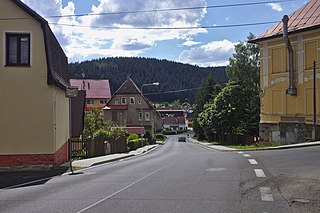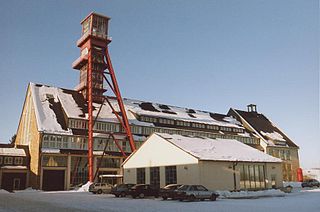
Jáchymov is a spa town in Karlovy Vary District in the Karlovy Vary Region of the Czech Republic. It has about 2,400 inhabitants.

Karlovy Vary District is a district in the Karlovy Vary Region of the Czech Republic. Its capital is the city of Karlovy Vary.

Kraslice is a town in Sokolov District in the Karlovy Vary Region of the Czech Republic. It has about 6,600 inhabitants. It was a large and important town until World War II. It is known for the manufacture of musical instruments.

Výsluní is a town in Chomutov District in the Ústí nad Labem Region of the Czech Republic. It has about 300 inhabitants.

Pernink is a municipality and village in Karlovy Vary District in the Karlovy Vary Region of the Czech Republic. It has about 600 inhabitants.

Kašperské Hory is a town in Klatovy District in the Plzeň Region of the Czech Republic. It has about 1,400 inhabitants. It is known as a ski resort. The historic town centre is well preserved and is protected by law as an urban monument zone.

Nejdek is a town in Karlovy Vary District in the Karlovy Vary Region, Czech Republic. It has about 7,600 inhabitants.

Ostrov is a town in Karlovy Vary District in the Karlovy Vary Region of the Czech Republic. It has about 16,000 inhabitants. The historic town centre is well preserved and is protected by law as an urban monument zone.

Krupka is a town in Teplice District in the Ústí nad Labem Region of the Czech Republic. It has about 13,000 inhabitants. The town is located in the Ore Mountain Mining Region, a UNESCO World Heritage Site, and during the late Middle Ages it was one of the world-leading producers of tin and silver. The centre of Krupka is well preserved and is protected by law as an urban monument zone.

Horní Slavkov is a town in Sokolov District in the Karlovy Vary Region of the Czech Republic. It has about 5,400 inhabitants. The historic town centre is well preserved and is protected by law as urban monument zone.

Bochov is a town in Karlovy Vary District in the Karlovy Vary Region of the Czech Republic. It has about 1,900 inhabitants.

Boží Dar is a town in Karlovy Vary District in the Karlovy Vary Region of the Czech Republic. It has about 400 inhabitants. Situated in the Ore Mountains at 1,028 m (3,373 ft) above sea level, it is considered the highest town in the Czech Republic. The town is part of the Abertamy – Boží Dar Mining Landscape, which is a UNESCO World Heritage Site as part of Ore Mountain Mining Region.

Habartov is a town in Sokolov District in the Karlovy Vary Region of the Czech Republic. It has about 4,700 inhabitants.

Horní Blatná is a town in Karlovy Vary District in the Karlovy Vary Region of the Czech Republic. It has about 400 inhabitants. The town is historically associated with tin mining and is located in the Ore Mountain Mining Region, which is a UNESCO World Heritage Site. The historic town centre is well preserved and is protected by law as an urban monument zone.

Luby is a town in Cheb District in the Karlovy Vary Region of the Czech Republic. It has about 2,200 inhabitants. It is well known for its violin-making industry, and was once dubbed the "Austrian Cremona" when Bohemia was part of Austria-Hungary.

Nová Role is a town in Karlovy Vary District in the Karlovy Vary Region of the Czech Republic. It has about 4,200 inhabitants.

Rotava is a town in Sokolov District in the Karlovy Vary Region of the Czech Republic. It has about 2,800 inhabitants.

Vejprty is a town in Chomutov District in the Ústí nad Labem Region of the Czech Republic. It has about 2,800 inhabitants. It lies along the border with Germany. Until World War II, it was a large town.

Jindřichovice is a municipality and village in Sokolov District in the Karlovy Vary Region of the Czech Republic. It has about 500 inhabitants.

The Ore Mountain Mining Region is an industrial heritage landscape, over 800 years old, in the border region of the Ore Mountains between the German state of Saxony and North Bohemia in the Czech Republic. It is characterised by a plethora of historic, largely original, monuments to technology, as well as numerous individual monuments and collections related to the historic mining industry of the region. On 6 July 2019, the Erzgebirge/Krušnohoří Mining Region was inscribed as a UNESCO World Heritage Site, because of its exceptional testimony to the advancement of mining technology over the past 800 years.


























